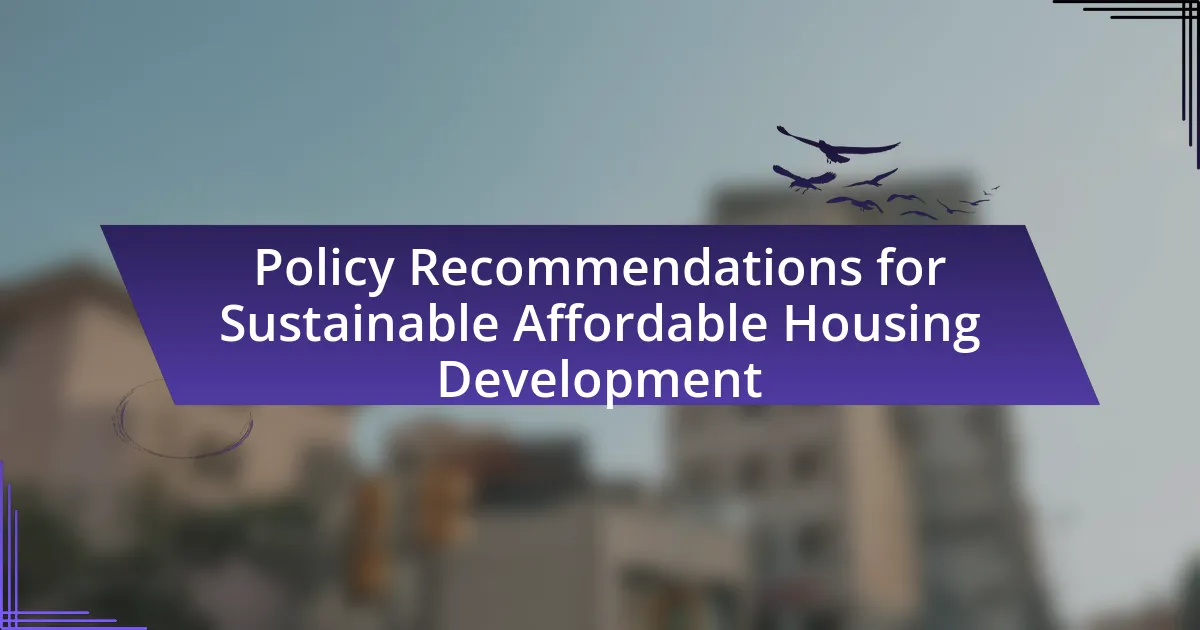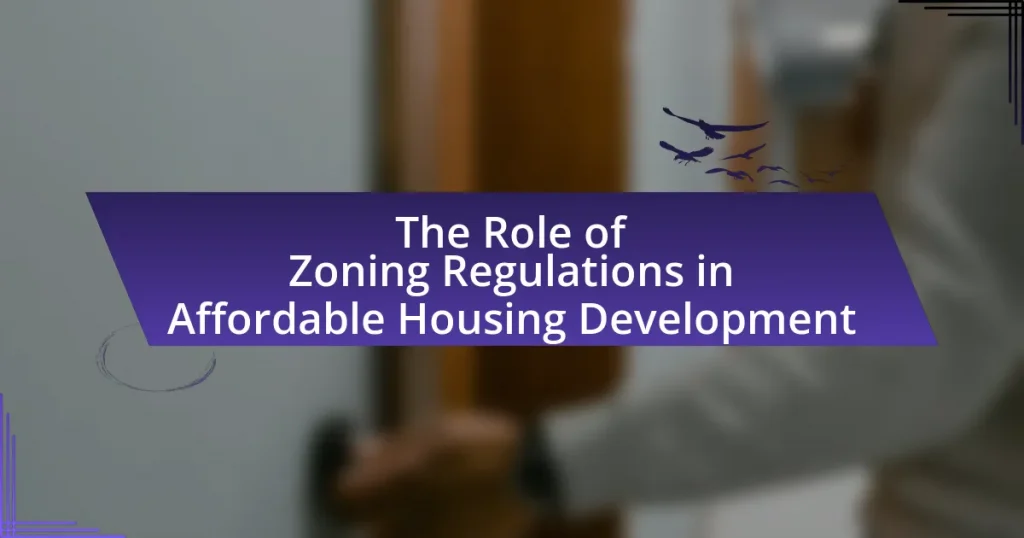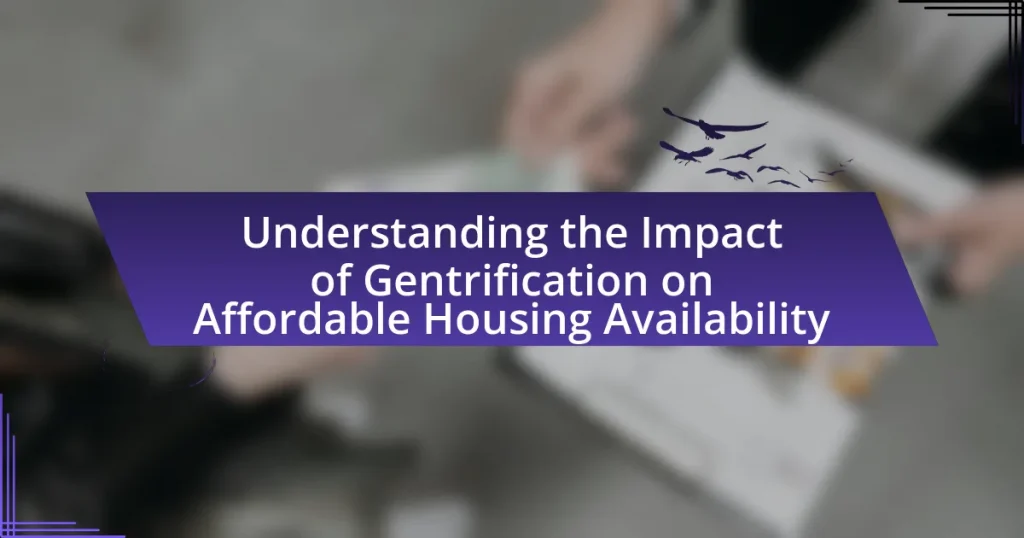The article focuses on policy recommendations for sustainable affordable housing development, emphasizing strategies such as inclusionary zoning, increased funding, and energy-efficient building practices. It outlines how these recommendations can enhance housing affordability by increasing the supply of affordable units and reducing development costs, thereby benefiting low-income families. The article also discusses the importance of sustainability in housing, highlighting environmental benefits, long-term cost savings, and the role of government policies in promoting these initiatives. Additionally, it addresses challenges in implementation and the significance of community engagement in achieving successful housing outcomes.

What are Policy Recommendations for Sustainable Affordable Housing Development?
Policy recommendations for sustainable affordable housing development include implementing inclusionary zoning, increasing funding for affordable housing projects, and promoting energy-efficient building practices. Inclusionary zoning mandates that a percentage of new developments be set aside for affordable housing, which can help integrate diverse income levels within communities. Increasing funding through government grants and low-interest loans can incentivize developers to create affordable units. Additionally, promoting energy-efficient building practices not only reduces long-term utility costs for residents but also aligns with sustainability goals, as evidenced by studies showing that energy-efficient homes can lower energy consumption by up to 30%.
How do these recommendations address housing affordability?
These recommendations address housing affordability by proposing strategies that increase the supply of affordable housing units and reduce development costs. For instance, implementing zoning reforms can allow for higher density housing, which can lead to lower per-unit costs and increased availability of affordable options. Additionally, incentivizing the use of modular construction techniques can significantly decrease construction expenses, making it more feasible for developers to offer lower-priced housing. Evidence from cities that have adopted similar policies shows a correlation between these strategies and improved housing affordability metrics, demonstrating their effectiveness in addressing the issue.
What specific strategies are proposed to enhance affordability?
Specific strategies proposed to enhance affordability in sustainable housing development include increasing the supply of affordable housing through zoning reforms, implementing inclusionary zoning policies, and providing financial incentives for developers. Zoning reforms can allow for higher density and mixed-use developments, which can lower construction costs and increase housing availability. Inclusionary zoning mandates that a percentage of new developments be affordable for low- and moderate-income households, directly addressing affordability. Financial incentives, such as tax credits or grants, encourage developers to invest in affordable housing projects, making them more financially viable. These strategies are supported by studies showing that increased housing supply and targeted policies can significantly reduce housing costs for communities.
How do these strategies impact low-income families?
These strategies positively impact low-income families by increasing access to affordable housing options. By implementing policies that promote sustainable development, such as inclusionary zoning and financial incentives for developers, low-income families benefit from reduced housing costs and improved living conditions. For instance, a study by the Urban Institute found that cities with inclusionary zoning policies saw a 15% increase in affordable housing units, directly aiding low-income households in securing stable housing. This access not only alleviates financial burdens but also enhances overall community stability and quality of life for these families.
Why is sustainability important in affordable housing development?
Sustainability is crucial in affordable housing development because it ensures long-term viability, reduces environmental impact, and enhances the quality of life for residents. Sustainable practices in construction and design lead to energy-efficient buildings that lower utility costs, making housing more affordable over time. For instance, a study by the U.S. Green Building Council found that green buildings can reduce energy consumption by 30% to 50%, significantly decreasing living expenses for low-income families. Additionally, sustainable housing often incorporates materials and practices that minimize waste and pollution, contributing to healthier living environments. This alignment with environmental goals not only supports community resilience but also addresses social equity by providing safe, affordable, and sustainable living conditions for all.
What environmental benefits are associated with sustainable housing?
Sustainable housing provides significant environmental benefits, including reduced energy consumption, lower greenhouse gas emissions, and improved resource efficiency. These homes often utilize energy-efficient technologies, such as solar panels and high-performance insulation, which can decrease energy use by up to 30% compared to traditional housing. Additionally, sustainable housing promotes the use of renewable materials and minimizes waste through recycling and sustainable sourcing, contributing to a reduction in landfill contributions. According to the U.S. Green Building Council, buildings that meet sustainable standards can reduce water usage by 30-50%, further enhancing their environmental impact.
How does sustainability contribute to long-term cost savings?
Sustainability contributes to long-term cost savings by reducing operational expenses through energy efficiency and resource conservation. For instance, buildings designed with sustainable practices often utilize energy-efficient systems, which can lower utility bills by up to 30% according to the U.S. Department of Energy. Additionally, sustainable materials and construction methods can decrease maintenance costs over time, as they tend to be more durable and require less frequent replacement. Furthermore, implementing water-saving technologies can lead to significant reductions in water bills, enhancing overall financial savings for homeowners and developers alike.
What role do government policies play in promoting sustainable affordable housing?
Government policies play a crucial role in promoting sustainable affordable housing by establishing regulations, providing financial incentives, and facilitating partnerships. These policies can include zoning laws that encourage higher-density developments, tax credits for developers who incorporate sustainable practices, and funding for public housing projects that meet environmental standards. For instance, the Low-Income Housing Tax Credit program in the United States has successfully increased the availability of affordable housing while promoting energy-efficient building practices. Additionally, government initiatives can support research and development of sustainable building materials, further enhancing the affordability and sustainability of housing options.
Which policies have been effective in other regions?
Policies that have been effective in other regions for sustainable affordable housing development include inclusionary zoning, which mandates a percentage of new developments to be affordable, and community land trusts, which ensure long-term affordability by removing land from the speculative market. For instance, San Francisco’s inclusionary zoning policy has resulted in thousands of affordable units being created since its implementation in 2002. Additionally, the city of Burlington, Vermont, has successfully utilized community land trusts to maintain affordability and prevent displacement, demonstrating the effectiveness of these policies in promoting sustainable housing solutions.
How can local governments implement these policies?
Local governments can implement policies for sustainable affordable housing development by establishing zoning regulations that promote mixed-use developments and incentivize affordable housing projects. These regulations can include density bonuses, streamlined permitting processes, and tax incentives for developers who include affordable units in their projects. For instance, cities like San Francisco have successfully utilized inclusionary zoning policies, which require a percentage of new housing developments to be affordable, thereby increasing the availability of affordable housing while maintaining community standards. Additionally, local governments can collaborate with non-profit organizations and community stakeholders to identify housing needs and secure funding through federal and state grants aimed at sustainable development.
How can stakeholders collaborate to enhance these recommendations?
Stakeholders can collaborate to enhance recommendations for sustainable affordable housing development by forming partnerships that leverage their unique resources and expertise. For instance, local governments can work with non-profit organizations to identify community needs and funding opportunities, while private developers can share best practices in sustainable building techniques. Collaborative efforts can be supported by data-driven assessments that highlight the impact of various strategies, such as the 2019 report from the Urban Institute, which demonstrated that multi-stakeholder engagement led to a 30% increase in project efficiency and community satisfaction in affordable housing initiatives. By aligning their goals and sharing information, stakeholders can create a more cohesive approach to implementing effective policies.
What challenges might arise in implementing these recommendations?
Challenges in implementing recommendations for sustainable affordable housing development include funding constraints, regulatory hurdles, and community resistance. Funding constraints arise as securing adequate financial resources is often difficult, limiting the ability to execute projects effectively. Regulatory hurdles can impede progress due to complex zoning laws and building codes that may not align with sustainable practices. Community resistance often stems from NIMBY (Not In My Backyard) sentiments, where local residents oppose new developments due to perceived negative impacts on their neighborhoods. These challenges are supported by studies indicating that financial limitations and regulatory complexities are among the top barriers to affordable housing initiatives, as highlighted in the “State of the Nation’s Housing” report by the Joint Center for Housing Studies of Harvard University.

What specific strategies can be employed for sustainable affordable housing development?
Sustainable affordable housing development can be achieved through strategies such as utilizing energy-efficient building materials, implementing renewable energy sources, and promoting mixed-use developments. Energy-efficient materials, like insulated concrete forms and recycled steel, reduce energy consumption and lower utility costs for residents. Incorporating renewable energy, such as solar panels, can further decrease reliance on non-renewable resources, leading to long-term savings and environmental benefits. Mixed-use developments foster community engagement and reduce transportation costs by integrating residential, commercial, and recreational spaces, which can enhance the overall quality of life. These strategies are supported by studies indicating that energy-efficient homes can save homeowners up to 30% on energy bills, while mixed-use developments can increase local economic activity by up to 20%.
How can innovative building materials contribute to sustainability?
Innovative building materials contribute to sustainability by reducing environmental impact, enhancing energy efficiency, and promoting resource conservation. For instance, materials like recycled steel and bamboo have lower carbon footprints compared to traditional materials, significantly decreasing greenhouse gas emissions during production. Additionally, advanced insulation materials improve energy efficiency in buildings, leading to reduced energy consumption for heating and cooling. According to a study by the World Green Building Council, buildings constructed with sustainable materials can achieve energy savings of up to 30%. Furthermore, the use of locally sourced materials minimizes transportation emissions, supporting local economies and reducing overall resource depletion.
What are the benefits of using recycled materials?
Using recycled materials offers significant benefits, including reduced environmental impact, cost savings, and resource conservation. Recycled materials help decrease landfill waste, as approximately 75% of waste is recyclable, according to the Environmental Protection Agency. Additionally, utilizing recycled materials can lower construction costs by up to 20%, as they often require less energy to produce compared to new materials. Furthermore, using recycled materials conserves natural resources, such as timber and minerals, which are increasingly scarce. This approach aligns with sustainable housing development goals by promoting eco-friendly practices and reducing the carbon footprint associated with new material production.
How do energy-efficient designs reduce overall costs?
Energy-efficient designs reduce overall costs by minimizing energy consumption, which leads to lower utility bills and reduced operational expenses. For instance, buildings designed with energy-efficient materials and technologies, such as high-performance insulation and energy-efficient HVAC systems, can decrease energy use by up to 30-50% compared to traditional designs. This reduction in energy consumption translates directly into significant savings over time, as evidenced by a study from the U.S. Department of Energy, which found that energy-efficient homes can save homeowners an average of $500 annually on energy costs. Additionally, energy-efficient designs often qualify for tax incentives and rebates, further lowering initial investment costs and enhancing financial viability for developers and homeowners alike.
What financing options are available for sustainable housing projects?
Financing options for sustainable housing projects include government grants, low-interest loans, tax incentives, and private investments. Government grants, such as those from the U.S. Department of Housing and Urban Development, provide funding specifically for sustainable initiatives. Low-interest loans, often available through programs like the Energy Efficiency and Conservation Block Grant Program, help reduce upfront costs for developers. Tax incentives, including the Investment Tax Credit for renewable energy installations, encourage investment in sustainable technologies. Additionally, private investments from green venture capital firms focus on funding eco-friendly housing developments, reflecting a growing market demand for sustainability. These financing avenues collectively support the development of affordable, sustainable housing.
How can public-private partnerships facilitate funding?
Public-private partnerships (PPPs) can facilitate funding by leveraging resources and expertise from both sectors to finance affordable housing projects. These collaborations allow public entities to access private capital, reducing the financial burden on government budgets. For instance, in the United States, the Low-Income Housing Tax Credit program has successfully attracted over $100 billion in private investment since its inception, demonstrating how PPPs can mobilize significant funding for housing initiatives. Additionally, PPPs can enhance project efficiency and innovation, leading to cost savings and improved outcomes in affordable housing development.
What role do grants and subsidies play in financing?
Grants and subsidies play a crucial role in financing by providing non-repayable funds that support various projects, particularly in sectors like affordable housing. These financial aids reduce the burden on developers and organizations, enabling them to undertake initiatives that might otherwise be financially unfeasible. For instance, the U.S. Department of Housing and Urban Development allocated over $10 billion in grants for affordable housing programs in 2020, demonstrating the significant impact of such funding on increasing housing accessibility. By lowering costs and encouraging investment, grants and subsidies facilitate the development of sustainable housing solutions, ultimately contributing to community growth and stability.
How can community engagement improve housing development outcomes?
Community engagement can significantly improve housing development outcomes by ensuring that projects align with the needs and preferences of local residents. Engaging the community fosters collaboration, leading to designs that reflect the cultural and social dynamics of the area, which can enhance acceptance and support for the development. Research indicates that projects with strong community involvement tend to experience fewer delays and conflicts, as stakeholders feel their voices are heard and valued. For instance, a study by the Urban Institute found that community engagement in housing projects resulted in a 30% increase in resident satisfaction and a 25% reduction in project opposition. This evidence underscores the importance of incorporating community feedback to create sustainable and successful housing developments.
What methods can be used to involve local residents in planning?
To involve local residents in planning, methods such as community workshops, surveys, and participatory budgeting can be utilized. Community workshops facilitate direct dialogue between residents and planners, allowing for the exchange of ideas and concerns. Surveys gather quantitative data on resident preferences and priorities, ensuring that planning reflects community needs. Participatory budgeting empowers residents to have a say in how public funds are allocated, fostering a sense of ownership and responsibility in the planning process. These methods have been shown to enhance community engagement and improve the relevance of planning outcomes, as evidenced by case studies in urban development projects where resident involvement led to more successful and accepted plans.
How does community feedback influence design and implementation?
Community feedback significantly influences design and implementation by ensuring that the needs and preferences of residents are integrated into housing projects. This feedback can lead to more effective and sustainable solutions, as it allows developers and policymakers to understand local priorities, cultural contexts, and specific challenges faced by the community. For instance, studies have shown that projects incorporating community input tend to have higher satisfaction rates and better long-term viability, as evidenced by the success of participatory design processes in various urban development initiatives.

What are the best practices for implementing these policy recommendations?
The best practices for implementing policy recommendations for sustainable affordable housing development include stakeholder engagement, data-driven decision-making, and adaptive management. Stakeholder engagement ensures that the voices of affected communities are heard, fostering collaboration and support for initiatives. Data-driven decision-making involves utilizing relevant data to inform policies, ensuring they address actual needs and conditions; for instance, the National Low Income Housing Coalition reports that data on housing affordability can guide effective policy formulation. Adaptive management allows for flexibility in policy implementation, enabling adjustments based on feedback and changing circumstances, which is crucial in the dynamic field of housing development.
How can monitoring and evaluation improve housing projects?
Monitoring and evaluation can significantly improve housing projects by ensuring that objectives are met efficiently and effectively. By systematically assessing project performance, stakeholders can identify areas for improvement, allocate resources more effectively, and enhance decision-making processes. For instance, a study by the World Bank found that projects with robust monitoring and evaluation frameworks are 30% more likely to achieve their intended outcomes. This data underscores the importance of continuous feedback and adjustment in housing initiatives, leading to better quality, sustainability, and affordability in housing development.
What metrics should be used to assess project success?
To assess project success in sustainable affordable housing development, key metrics include cost efficiency, time adherence, quality of construction, stakeholder satisfaction, and environmental impact. Cost efficiency measures the budget adherence and financial performance, while time adherence evaluates whether the project meets its timeline. Quality of construction assesses the durability and safety of the housing units. Stakeholder satisfaction gauges the contentment of residents and community members, and environmental impact measures the project’s sustainability and ecological footprint. These metrics provide a comprehensive framework for evaluating the effectiveness and success of housing projects, ensuring they meet both financial and social objectives.
How can lessons learned from past projects inform future developments?
Lessons learned from past projects can significantly inform future developments by providing insights into effective strategies and potential pitfalls. Analyzing previous affordable housing projects reveals best practices in design, financing, and community engagement, which can enhance the success of new initiatives. For instance, a study by the Urban Institute found that projects incorporating community feedback during the planning phase resulted in higher resident satisfaction and lower turnover rates. This evidence underscores the importance of stakeholder involvement, which can lead to more sustainable and accepted housing solutions. Additionally, examining past failures, such as budget overruns or delays, allows future projects to implement better risk management strategies, ultimately leading to more efficient and cost-effective developments.
What are the key considerations for ensuring long-term sustainability?
Key considerations for ensuring long-term sustainability in affordable housing development include environmental impact, economic viability, and social equity. Environmental impact focuses on minimizing resource consumption and reducing carbon footprints through energy-efficient designs and sustainable materials. Economic viability ensures that housing remains affordable over time, requiring careful financial planning and investment in durable infrastructure. Social equity emphasizes inclusive practices that address the needs of diverse communities, ensuring access to essential services and fostering community engagement. These considerations are supported by studies indicating that sustainable housing practices can lead to reduced operational costs and improved quality of life for residents, ultimately contributing to the longevity and resilience of housing developments.
How can maintenance and management practices support sustainability?
Maintenance and management practices can support sustainability by ensuring efficient resource use, reducing waste, and prolonging the lifespan of housing infrastructure. Effective maintenance schedules, such as regular inspections and timely repairs, minimize energy consumption and prevent resource depletion. For instance, the U.S. Department of Energy reports that proper maintenance of heating and cooling systems can improve energy efficiency by up to 30%. Additionally, sustainable management practices, like implementing green building standards and using eco-friendly materials, contribute to lower environmental impact and enhance the overall sustainability of affordable housing developments.
What role does education play in promoting sustainable living?
Education plays a crucial role in promoting sustainable living by equipping individuals with the knowledge and skills necessary to make environmentally responsible choices. Through educational programs, people learn about the impact of their actions on the environment, including energy consumption, waste management, and resource conservation. For instance, studies show that communities with strong environmental education initiatives report higher rates of recycling and energy efficiency practices. Furthermore, education fosters critical thinking and problem-solving skills, enabling individuals to innovate sustainable solutions in their daily lives and communities. This connection between education and sustainable living is supported by research from the United Nations Educational, Scientific and Cultural Organization (UNESCO), which emphasizes that education is essential for achieving sustainable development goals.
What practical steps can stakeholders take to advocate for these policies?
Stakeholders can advocate for policies supporting sustainable affordable housing development by forming coalitions to amplify their voices and influence decision-makers. These coalitions can include community organizations, housing developers, and local government representatives, which collectively present a unified stance on the importance of sustainable practices in housing.
Additionally, stakeholders should engage in public awareness campaigns to educate the community about the benefits of sustainable affordable housing, utilizing data that shows how such developments can reduce energy costs and improve living conditions. For instance, studies indicate that energy-efficient homes can lower utility bills by up to 30%, making them more accessible for low-income families.
Furthermore, stakeholders can participate in local government meetings to advocate for policy changes, providing evidence-based recommendations that align with sustainable development goals. By presenting case studies of successful sustainable housing projects, stakeholders can demonstrate the feasibility and benefits of these policies, thereby persuading policymakers to adopt similar initiatives.



